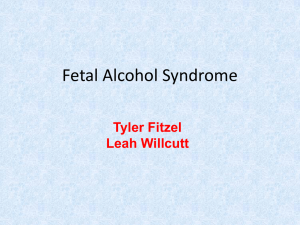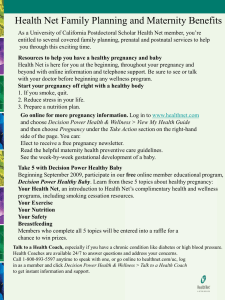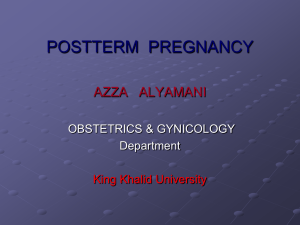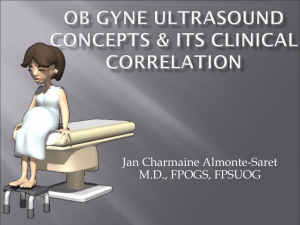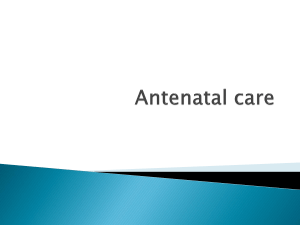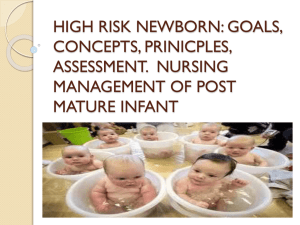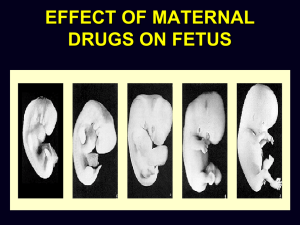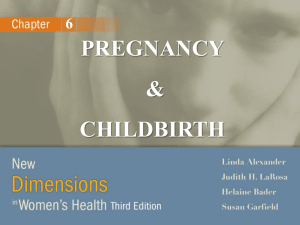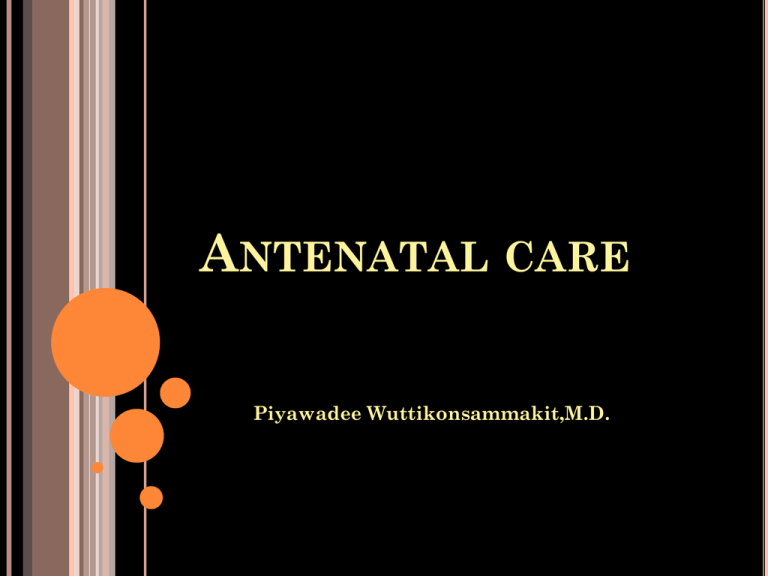
ANTENATAL CARE
Piyawadee Wuttikonsammakit,M.D.
SCOPE
การดูแลทัว่ ไปในระยะก่อนคลอด
Risk detection : hypertension in pregnancy,
gestational DM, elderly gravida, thalassemia,
size date
DIAGNOSIS OF PREGNANCY
Signs & symptoms : cessation of menstruation,
hyperemesis, breast changes, uterus and cervical
changes, perception of fetal movements
Pregnancy test : UPT, βhCG
Ultrasonographic findings
MAJOR GOALS OF PRENATAL EVALUATION
Define the health status of the mother and fetus
Estimate the gestational age
Initiate a plan for continuing obstetrical care
HISTORY
Menstrual history : interval, duration,
LMP&PMP, contraception
Past obstetrical history
Past history : underlying disease, surgery
Family history
Personal history : alcohol, cigarette
Psychosocial screening : transportation, child
care, family support, unintended pregnancy,
nutrition, depression
Updated history taking every visit (symptoms)
EDC (EXPECTED DATE OF CONFINEMENT)
LMP + 7 วัน – 3 เดือน
ประจาเดือน มาสมา่ เสมอหรือไม่ interval, duration, amount
(pad/day), PMP
Contraception
Quickening
PAST OBSTETRIC HISTORY
คลอด : อายุครรภ์ นา้ หนักทารกแรกคลอด route of delivery พร้อมเหตุผล
ขณะนี้เด็กอายุเท่าไหร่ แข็งแรง หรือมีโรคประจาตัวหรือไม่
ภาวะแทรกซ้อนระหว่างตัง้ ครรภ์ก่อน เช่น เบาหวาน ครรภ์เป็ นพิษ คลอดก่อนกาหนด นา้ เดิน
ก่อนการเจ็บครรภ์
แท้ง : ทาแท้ง หรือแท้งเอง อายุครรภ์ ขูดมดลูกหรือไม่ หาก termination of
pregnancy บอกเหตุผล
PAST HISTORY
โรคประจาตัว : โรคหัวใจ ความดันโลหิตสูง เบาหวาน ไทรอยด์ โลหิตจาง พร้อมรายละเอียด
status, การรักษาปัจจุบนั
ประวัตผ
ิ า่ ตัด : โดยเฉพาะผ่าตัดมดลูก ปากมดลูก และรังไข่ รวมถึงผลชิ้นเนื้อ
ประวัตค
ิ รอบครัว : เบาหวาน คลอดบุตรผิดปกติ โรคทางพันธุกรรม
อาการผิดปกติทอี่ าจพบ
คลื่นไส้อาเจียน
เวียนศีรษะ
เลือดออกทางช่องคลอด
ปวดท้องน้อย
ปั สสาวะบ่อย
ถ่ายลาบาก ถ่ายมีเลือดออก
ท้องแข็งจากการหดรัดตัวของมดลูก
มีมูกเลือดออกทางช่องคลอด
นา้ เดิน
ลูกดิ้นน้อยลง
PHYSICAL EXAMINATION
General physical examination : especially first
visit
Pelvic examination (consider)
Every visit :
BP
Body weight
Fundal height
Leopold’s maneuver : fetal position
FHR
HYPERTENSION IN PREGNANCY
Gestational hypertension
Mild preeclampsia
Severe preeclampsia
Chronic hypertension
Chronic hypertension with superimposed
preeclampsia
GESTATIONAL HYPERTENSION
BP >= 140/90
No proteinuria
BP returns to normal before 12 weeks
postpartum
Final diagnosis made only postpartum
May have S&S of preeclampsia : epigastric
discomfort or thrombocytopenia
PREECLAMPSIA
Mild preeclampsia : BP >= 140/90 after 20 weeks,
proteinuria >= 300 mg/24hours or >= 1+ dipstick
Severe preeclampsia : BP >= 160/110, proteinuria
2.0 g/24 hours or >= 2+ dipstick, Cr > 1.2,
platelets < 100,000, MAHA, elevated ALT or
AST, presistent headache or visual disturbance,
epigastric pain
Eclampsia : seizures
CHRONIC HYPERTENSION
Chronic hypertension
BP >= 140/90 before pregnancy or Dx before 20 weeks
or Dx after 20 weeks and persistent after 12 weeks
postpartum
Superimposed preeclampsia
New onset proteinuria, but no proteinuria before 20
weeks
A sudden increase in proteinuria or
BP or platelet < 100,000
RECOMMENDATIONS FOR WEIGHT GAIN
Category
BMI (kg/m2)
Recommended
TWG (kg)
Low
Normal
High
Obese
<19.8
19.8-26
26-29
>29
12.5-18
11.5-16
7-11.5
>=7
FUNDAL HEIGHT
SIZE DATE
Size
date
Wrong date
Full bladder
Molar pregnancy
Multifetal pregnancy
Polyhydramnios
Macrosomia
Myoma
Ovarian tumor
Size
date
IUGR
Fetal death
Wrong date
SIZE DATE
Ultrasound
LEOPOLD’S MANEUVER
LEOPOLD’S MANEUVER
LEOPOLD’S MANEUVER
LEOPOLD’S MANEUVER
BREECH OR TRANSVERSE
Ultrasound confirm
Refer for delivery
ASSESSMENT OF GA
The most important
Fundal height : Jeminez 20-34 wk
Fetal heart sound : stethoscope 16-19wk, heard
in all by 22 wk, Doptone 10 wk, TVS 5-6wk
Sonography : first trimester screening for
aneuploidy followed by a standard scan in second
trimester
GA ESTIMATION IN LATE TRIMESTER
Late pregnancy US measurements should never
be used to change an EDC established by an
examination performed earlier in pregnancy.
A single late examination cannot reliably
distinguish between a pregnancy that is
misdated and younger than expected, and a
pregnancy that is complicated by fetal growth
restriction.
WHICH BIOMETRIC PARAMETERS?
BPD 3-4 weeks in mid to late third trimester
FL 2.1 - 3.5 weeks in third trimester
Multiple biometric parameters the best test
performance with the least variability
Additional measurement : transverse cerebellar
diameter, cardiac area/circumference
When menstrual dates are discordant with the
GA suggested by a late pregnancy US serial
measurements
ADDITIONAL PARAMETERS
Transverse cerebellar
diameter (TCD)
Cardiac area/circumference
(CA/CC)
LAB ANC
Lab
First visit
15-20 wk
Hct or Hb
*
Blood type &
Rh
*
AntiHIV
*
* (high risk)
VDRL
*
* (high risk)
HBsAg
*
Antibody
screen
*
29-41 wk
* (28-32wk)
*(28 wk
Rhogram if
unsensitized)
*
GCT
PAP smear
*
Fetal
aneuploidy
screening
*
Rubella Ab
*
UA, U/C
*
GBS culture
24-28 wk
*(offered)
*(35-37wk)
IMMUNIZATION
Vaccine
Type
Indications during
pregnancy
Measles, Mumps,
Rubella, Varicella,
Smallpox
Live attenuated
Contraindicated
Poliomyelitis, yellow
fever
Live attenuated
Travel to high-risk
areas
Influenza
Inactivated virus
vaccine
All women,
regardless of
trimester
Rabies
Killed virus
Postexposure
prophylaxis
Hepatitis B
Live attenuated
Pre&postexposure for
high-risk women
Typhoid
Killed or live
attenuate oral
Travel to high-risk
areas
IMMUNOGLOBULINS & TOXOID
Vaccine
Indication
Hepatits B Ig (HBIG)
Postexposure prophylaxis
Rabies Ig (ERIC, HRIG)
Postexposure prophylaxis
Tetanus antitoxin (TAT)
Postexposure prophylaxis
Varicella Ig (VZIG)
Within 96 hr of exposure
Also indicated for NB of women who
developed varicella within 4 days before or
2 days following delivery
Tetanus toxoid : combined tetanus-diphtheria
toxoids preferred
Primary : 1,2,6-12 mo
Booster : single dose every 10 years after
completion
ความผิดปกติของผล LAB
VDRL – reactive
HBsAg-positive
AntiHIV – positive
Rh-negative
SYPHILIS
Primary syphilis : ulcer, chancre
Secondary syphillis : skin rash, mucocutaneous
lesion, lymphadenopathy
Neurologic syphilis : cranial nerve dysfunction,
meningitis, stroke, altered mental status, loss
vibration sense, auditory or ophthalmic
abnormalities
Tertiary syphilis : cardiac or gummatous lesions
VDRL - REACTIVE
Latent syphilis : serologic positive, lacking
clinical manifestation
Early latent syphilis acquired within the
preceding year
All other cases of latent syphilis are either late
latent syphilis or latent syphilis of unknown
duration.
Diagnosis : FTA-ABS
VDRL decline after treatment
TREATMENT LATENT SYPHILIS IN
PREGNANCY
Benzathine Penicillin G 2.4 million unit IM * 3
doses at 1 week interval
Pregnant patients who are allergic to penicillin
should be desensitized and treated with penicillin
Alternative for late latent or unknown
Doxycycline (100 mg orally twice daily) or
tetracycline (500 mg orally four times daily), both for
28 days (not used in pregnancy)
Ceftriaxone 2 gm IM 10-14 days (insufficient data)
Erythromycin and azithromycin should not be used,
because neither reliably cures maternal infection or
treats an infected fetus
TREATMENT LATENT SYPHILIS IN
PREGNANCY
Sonographic signs of fetal and placental syphilis
(i.e. hepatomegaly, ascites, hydrops, fetal anemia,
or a thickened placenta) indicate a greater risk
for fetal treatment failure
Women treated for syphilis during the second
half of pregnancy are at risk for premature labor,
fever and/or fetal distress if the treatment
precipitates the Jarisch-Herxheimer reaction
RH -NEGATIVE
D-negative nonsensitized mother
AntiD immunoglobulin 300 ug IM at 28 weeks
and after delivery
Sensitized mother (AntiD titer 1:16)
Follow up MCA PSV > 1.5 MoM
Intrauterine transfusion
CAUSE OF FETOMATERNAL HEMORRHAGE
Early pregnancy loss :
Miscarriage
Missed abortion
Elective abortion
Ectopic pregnancy
Procedures :
Chorionic villus sampling
Amniocentesis
Fetal blood sampling
Other :
Idiopathic
Maternal trauma
Manual placental removal
External version
ASYMPTOMATIC BACTERIURIA (ASB)
Persistent, actively multiplying bacteria within
the urinary tract in asymptomatic women
Prevalence 5-6%
A clean-voided urine culture containing more
than 100,000 organisms per milliliter is
diagnostic
If not treat, 25% will develop symptomatic
infection during pregnancy
If prevalence is low, the screening leukocyte
esterase-nitrite dipstick may be used
ASB TREATMENT
Single dose treatment
Amoxicillin 3 gm
Ampicillin 2 gm
Cephalosporin 2 gm
Nitrofurantoin 200 mg
TMP/SMZ 320/1600 mg
3 day course
Amoxicillin 500 mg 1x3
Ampicillin 250 mg 1x4
Cephalosporin 250 1x4
Ciprofloxacin 250 1x2
Levofloxacin 250 1x1
Nitrofurantoin 100 mg
1x2
TMP/SMZ 180/800 1x2
COMPLICATION IN FIRST TRIMESTER
Abortion
Blighted ovum (anembryonic pregnancy)
Embryonic death
Ectopic pregnancy
Molar pregnancy
BLIGHTED OVUM : THRESHOLD CRITERIA
Anembryonic
pregnancy
TAS :
MSD 20 mm.
without yolk sac
MSD 25 mm.
without embryo
TVS
:
MSD 8 mm.
without yolk sac
MSD 16 mm.
without embryonic
pole
BLIGHTED OVUM
22% (135 pt) without yolk sac seen at 8 mm. MSD
go on pregnancy
8% (59 pt) with MSD >16 mm. but no embryonic
pole later develop live embryo
Rowling SE, Coleman BG, Langer JE, et al. First-trimester US parameters of failed pregnancy. Radiology.
1997; 203:211–217.
COMMON HIGH RISK PREGNANCY
Elderly gravida
Couple at risk thalassemia
GDM
Obstetric complication : preterm, PROM, twin,
placenta previa, previous C/S, postterm
Fetal complication : IUGR, fetal anomalies
Medical disease : Heart disease, renal disease,
SLE, anemia, thyroid disease
ELDERLY GRAVIDA
Risk Down syndrome
Screening DM
กราฟแสดงอัตราความเสีย่ ง(เป็ นร้อยละ)ต่อการมีบุตรเป็ นดาวน์ในแต่ละช่วงอายุ
2.00
1.50
1.00
0.50
0.00
20- 25- 30- 32 33 34 35 36 37 38 39 40 41 42
24 29 31
อายุ
ADVANCED MATERNAL AGE
ศีรษะเล็กแบน ตาเฉียง หูเล็ก จมูกแบน ลิ้นใหญ่
ปั ญญาอ่อน
ความพิการทางกายอืน่ ๆ ; หัวใจ,ทางเดินอาหาร,
เม็ดเลือดขาวผิดปกติ
สาเหตุของ DOWN SYNDROME
Trisomy 21
(nondisjunction
during meiosis)
95%
Translocation
Mosaicism
*Recurrence risk 1% for
any trisomy until it is
exceeded by her agerelated risk
PRENATAL DIAGNOSIS
Chorionic villi sampling
Perform at 10-13 wk
Transcervical or
transabdominal
Complication:
Fetal loss rate 3.5%
AF leakage & infection < 0.5%
Limitation:
Contamination
Uninformative result :
inadequate tissue, confined
placental mosaicism
PRENATAL DIAGNOSIS
Amniocentesis
Perform
at 16-20 wk
Complications :
Fetal loss rate 0.5%
AF leakage 1%
Chorioamnionitis
<0.1%
Needle injury to fetus
very rare
PRENATAL DIAGNOSIS
Fetal blood sampling
Cordocentesis: Ultrasondguided umbilical cord
needling
Perform at 18 wk up
Complication :
Fetal loss rate 1.4%
Cord hematoma 17%
Bradycardia 3-12%
Fetomaternal hemorrhage
40%
Infection <1%
ผลเลือดทีต่ อ้ งมีกอ่ นเจาะนา้ ครา่
CBC with platelet
่ งต่อความผิดปกติของการแข็งตัวของเลือด)
(PT, PTT หากมีความเสีย
Rh blood group
AntiHIV
Thalassemia screening : Hb typing
ประโยชน์ และข้อจากัด ของการเจาะนา้ ครา่
ทราบเพศทารก ทราบความผิดปกติของโครโมโซมอืน่
เพาะเลี้ยงเซลล์ไม่ข้ นึ เนื่องจากเจาะได้ปริมาณนา้ ครา่ น้อย หรือเจาะเมื่ออายุครรภ์นอ้ ยเกินไป
ไม่สามารถตรวจความผิดปกติในระดับยีนได้
รอผลการตรวจนา้ ครา่ ประมาณ 4 สัปดาห์
WOMEN WITH INCREASED RISK OF FETAL
ANEUPLOIDY
Singleton pregnancy and maternal age older than
35 at delivery
Dizygotic twin and maternal age older than 31 at
delivery
Previous autosomal trisomy birth
Previous 47,XXX or 47,XXY birth
Patient or partner is carrier of chromosome
translocation or inversion
History of triploidy
Some cases of repetitive early pregnancy losses
Patient or partner has aneuploidy
Major fetal structural defect by sonography
DOWN SYNDROME SCREENING TEST
First trimester
screening
Ultrasound : Nuchal
translucency
Biochemical :
freeBhCG, PAPP-A
Additional
ultrasound markers
: nasal bone,
frontomaxillary
facial angle, ductus
venosus flow,
tricuspid
regurgitation
Second trimester
screening
Ultrasound : major
defects, soft
markers
Biochemical : AFP,
BhCG, uE3, inhibin
A
ULTRASOUND SCREENING FOR DOWN
SYNDROME IN SECOND TRIMESTER
Major defects :
Cardiac defect
(AVSD, VSD)
Duodenal
atresiaesophageal
atresia
Exomphalos
Ventriculomegaly
Cystic hygroma
Hydrops
Soft markers :
Nuchal fold thickness
Pyelectasis
Hyperechogenic bowel
Intracardiac echogenic
foci
Short humerus
Short femur
THALASSEMIA SCREENING
SEVERE THALASSEMIA IN THAILAND
Homo -Thal
-Thal/Hb E
Hb Bart’s
DETECT HIGH RISK COUPLES
Hb Bart’s hydrops fetalis
a -thal1 trait
Hb H disease
Severe -thalassemia syndromes
(Homozygous -thal disease and -thal/HbE disease)
-thalassemia trait
Hb E trait
CARRIER SCREENING METHODS
• Identify hypochromic
microcytic rbc
•Single tube osmotic
fragility test 0.36% NSS
• Red cell indices : MCV,
MCH
•Identify Hb E genes
•DCIP
•Hemoglobin
electrophoresis
SINGLE TUBE OSMOTIC FRAGILITY TEST (OF)
• 0.36 % Saline Solution
- Normal - แตกหมด
- Thalassemia trait /
Homozygous Hb E - แตกไม่หมด
• Sensitivity : Beta - thal 90%,
Alpha- thal 1 93%
• False positive - Normal 5%
- Iron deficiency
RED CELL INDICES
MCV<80 fl (normal range)
MCH < 27 pg (normal range 26-30)
RDW (increase in Fe-def, HbH, a-thal minor)
RBC count (decrease in Fe-def)
Carriers of HbE, HbC, sickel cell trait, usually
have normal CBC results
DCIP- DICHOROPHENOLINDOPHENOL DYE
Abnormal Hb - HbE
Sensitivity 95 %
คูท่ ี่ 1
Hct
MCV/OF
DCIP
Hb typing
33.3
70.4
negative
A2A;
A2/E=2.3%,
A 61.3%
41.8
70.3
negative
A2A;
A2/E=2.9%,
A 60.2%
แปลผล
R/O couple at risk alpha thal
PCR alpha thal DNA
Prenatal diagnosis if risk Bart’s hydrops
คูท่ ี่ 2
Hct
MCV/OF
DCIP
Hb typing
33.3
78
positive
EA;
E=27%,
A 61.3%
41.8
70.3
negative
A2A;
A2/E=6.9%,
A 60.2%
couple at risk β thal/HbE
PCR β thal DNA ผูป้ ่ วยและสามี
Prenatal diagnosis
แปลผล
คูท่ ี่ 3
Hct
MCV/OF
DCIP
Hb typing
33.3
70.4
positive
EA;
E=23%,
A 61.3%
41.8
70.3
negative
A2A;
A2/E=6.9%,
A 60.2%
แปลผล
Couple at risk β thal/HbE 25%
R/O couple at risk alpha thal
PCR α and β thal DNA
Prenatal diagnosis
คูท่ ี่ 4
Hct
MCV/OF
DCIP
Hb typing
33.3
70.4
positive
EA;
E=23%,
A 61.3%
41.8
70.3
negative
A2A;
A2/E=2.9%,
A 60.2%
แปลผล
R/O couple at risk alpha thal
PCR alpha thal DNA
Prenatal diagnosis if risk Bart’s hydrops
คูท่ ี่ 5
Hct
MCV/OF
DCIP
Hb typing
33.3
57.4
positive
EF;
E=87.4%,
F = 3.9%
41.8
70.3
negative
A2A;
A2/E=6.9%,
A 60.2%
แปลผล
Couple at risk β thal/HbE 50%
R/O couple at risk alpha thal
PCR α and β thal DNA
Prenatal diagnosis
คูท่ ี่ 6
Hct
MCV/OF
DCIP
Hb typing
33.3
70.4
positive
EA;
E=27%,
A 61.3%
41.8
70.3
negative
EA;
E=26.9%,
A 60.2%
แปลผล
R/O couple at risk alpha thal
F/U Ultrasound until 28 wk
Hemoglobin electrophoresis
and Quantitation of Hb A2
Normal
PCR detection of
alpha - thal 1 (SEA)
Negative
Abnormal
Thal : Beta - thal trait, Hb H
Hemoglobinopathies: Hb E, EE
Alpha - thal 1 trait
Offer genetic counseling,
consider partner or relatives testing
Abnormal
Thal syndrome
unlikely
Offer genetic counseling and
options for couples at risk
Normal
No risk of
thal disease
GENETIC COUNSELING
1.
Risk assessment
2. Disease, its burden, and treatment
3. Option for prenatal diagnosis (including
methods, information, fetal loss rate,
reliability, rapid)
4. Option for termination of pregnancy,
recurrence risk, PGD
PRENATAL DIAGNOSIS
Chorionic villi
sampling for PCR
DNA
Amniocentesis for
PCR DNA
Fetal blood
sampling for Hb
typing
ULTRASOUND + CORDOCENTESIS (HB
BART’S)
Prehydropic signs
Cardiomegaly
MCA PSV > 1.5
MoM for GA
HYDROPIC SIGNS
Pericardial effusion
Ascites
Pleural effusion
Skin edema
Oligohydramnios
Placentomegaly
Prenatal Diagnosis of
Hb Bart’s hydrops fetalis
10 - 14 wk. G.A.
18 - 22 wk. G.A.
Amniocentesis
CVS
(Chorionic villi sampling)
DNA analysis
PCR detection (SEA deletion)
Cordocentesis
(U/S guide)
Hb electrophoresis
Hb Bart’s >80%
COUPLE AT RISK OF HOMOZYGOUS ALPHA -THALASSEMIA 1*
Serial USG at 12 - 14 weeks
18 - 20 weeks
28 - 32 weeks
Sign of fetal anemia
(Cardiomegaly, placental thickness)
Cordocentesis
Hb Electrophoresis
*(MCV < 80fl, MCH < 25 pg and normal Hb typing)
Prenatal Diagnosis of Homo -thal /
-thal/Hb E
DNA study
Common mutation detected
Yes
10 - 14 wk. G.A.
CVS
(Chorionic villi sampling)
No
16-22 wk. G.A.
Amniocentesis
DNA analysis
gene amplification, reverse dot blot hybridization
Cordocentesis
(U/S guide)
HPLC, DNA sequencing
Weatherall 2001
DM SCREENING
Low risk
Average risk
High risk
DM SCREENING
Low risk : test not routinely required
Member of an ethnic group with low prevalence of
GDM
No known diabetes in first-degree relatives
Age <25 years
Weight normal before pregnancy
Weight normal at birth
No history of abnormal glucose metabolism
No history of poor obestetrical outcome
DM SCREENING
Average risk : perform test at 24-28 weeks
Two step procedure : 50 gm GCT, followed by 100 gm
OGTT
One-step procedure : 100 gm OGTT all subjects
High risk : perform test as soon as feasible, if
GDM is not diagnosed, repeat at 24-28 weeks or
at any time there are symptoms or signs of
hyperglycemia
Severe obesity
Strong family history of type 2 diabetes
Previous history of GDM, impaired GT, or glucosuria
GDM DIAGNOSIS
Time
NDDG
Fasting
1hr
105
190
CarpenterCoustan
95
180
2hr
3hr
165
145
155
140
GDM
Fasting
A1 (diet)
<105 and
>120
A 2 (insulin)
>=105 or
>=120
2hr
postprandial
MATERNAL AND FETAL EFFECTS
Fetal anomalies are not increased
Fetal death/ unexplained stillbirth
Increased frequency of hypertension
Cesarean delivery
Macrosomia
TREATMENT
Diabetic diet 30 kcal/kg/d (prepregnancy
nonobese women) C:P:F 55:20:25 divided into
three meals and three snacks
Glucose monitoring
Fasting < 95 mg/dl, 1hr postprandial < 140 mg/dl,
2 hr postprandial < 120 mg/dl
Insulin therapy
Antepartum fetal testing
POSTPARTUM FOLLOW UP
75 gm OGTT at 6-12 weeks
50% likelihood of women with GDM developing
overt diabetes within 20 years
Increase risk dyslipidemia, hypertension,
abdominal obesity (metabolic syndrome)
Recurrence of GDM 40%
Contraception : low dose pills safe
75 GM OGTT
normal
Fasting
<110
mg/dl
2hr < 140
mg/dl
Impaired DM
GT
110-125
>= 126
mg/dl
mg/dl
2hr >=
2hr >=
140 – 199 200 mg/dl
mg/dl
MULTIFETAL GESTATION
Diagnosis of twin pregnancy
ZYGOSITY & CHORIONICITY
Dizygous
Dichorionic
Monozygous
Monochorionic
AMNIONICITY
DETERMINATION
Based
on visualization of intertwin
membrane
Monoamnionicity
increases risk of
TTTS, cord entanglement, shared
organs, and fetal death
Evaluation
becomes increasingly
difficult as the pregnancy progresses
and also limited by oligohydramnios in
one or more of the fetal compartments
chorionicity determination
chorionicity determination
chorionicity determination
CHORIONICITY DETERMINATION
External
The
genitalia
numbers of placental masses
Qualitative
analysis of intertwin
membrane, particularly the base
•Same sex twins with a single placental mass and
thin septum are likely to be monochorionic.
(Accuracy 80-90%)
CHORIONICITY
Risk
RELEVANCE
of perinatal morbidity & mortality
Risk of genetic & structural abnormality
Invasive testing & management of
discordant abnormality
Feasibility of multiple pregnancy reduction
Risk of sequelae in the presence of fetal
compromise
Early detection & management of TTTS
IUGR
25%
of twins being small for gestational age
Two
thirds of cases are discordant
Predictors
for bad outcome
MC : Weight discordancy in TTTS
DC : Small for gestational age
Management
in DC twins
needs modification, especially
AMNIOTIC
FLUID VOLUME
Oligohydramnios
Overall AFI
DVP in either sac
<5
<2
cm
cm
Polyhydramnios
Overall AFI
DVP in either sac
> 25 cm
> 8 cm
TTTS
TWIN-TWIN TRANSFUSION SYNDROME
Diagnosis
Monochorionicity
Marked
discordance in amniotic fluid
volume between the twins
Discordance
in size with the larger twin in
the polyhydramniotic sac
Fetal anomalies are excluded
ANTEPARTUM
Doppler
FETAL SURVEILLANCE
velocimetry
Abnormal UA Doppler
AEDF in UA of donor
AEDF in DV of recipient
Biophysical
Growth restriction
Poor outcome in TTTS
profile
80% sensitivity for adverse perinatal outcome
Lodeiro et al, 1986.
การดูแลสตรีตงั้ ครรภ์ตามแนวทางใหม่
ทาขึ้นเพือ่ ใช้เฉพาะกับสตรีตงั้ ครรภ์ท่ีไม่มีภาวะแทรกซ้อน
(low risk pregnancy) เท่านัน้
CLASSIFYING FORM
ประวัตอิ ดีต
เคยมีทารกตายในครรภ์ หรือเสียชีวต
ิ แรกเกิด (1 เดือนแรก)
เคยแท้งเอง 3 ครัง้ หรือมากกว่า ติดต่อกัน
เคยคลอดบุตรนา้ หนักน้อยกว่า 2500 กรัม
เคยคลอดบุตรนา้ หนักมากกว่า 4000 กรัม
เคยเข้ารับการรักษาพยาบาลเพราะความดันโลหิตสูงระหว่างตัง้ ครรภ์หรือครรภ์เป็ นพิษ
เคยผ่าตัดอวัยวะในระบบสืบพันธุ ์ เช่น ผ่าตัดคลอด ผ่าตัดเนื้องอกมดลูก ผ่าตัดปากมดลูก ผูก
ปากมดลูก
CLASSIFYING FORM (CONT.)
ประวัตคิ รรภ์ปัจจุบนั
ครรภ์แฝด
อายุ < 17 ปี (นับถึง EDC)
อายุ > 35 ปี (นับถึง EDC)
Rh negative
เลือดออกทางช่องคลอด
มีกอ้ นในอุง้ เชิงกราน
ความดันโลหิต diastolic > 90 mmHg
CLASSIFYING FORM (CONT.)
ประวัตทิ างอายุรกรรม
เบาหวาน
โรคไต
โรคหัวใจ
ติดยาเสพติด, ติดสุรา
่ ๆ เช่น โลหิตจาง ไทรอยด์ SLE ฯลฯ
โรคอายุรกรรมอืน
ถ้าพบข้อใดข้างหนึ่งขัน
้ ต้นแสดงว่าใช้การดูแลแนวใหม่ ไม่ได้ ควรได้รบั การดูแลพิเศษและหรือ
ประเมินเพิ่มเติม
องค์ประกอบพื้นฐานการดูแล
1. สอบถามข้อมูลทัว่ ไป
2. การตรวจร่างกาย
3. การตรวจทางห้องปฏิบต
ั กิ าร
4. การประเมินเพื่อการส่งต่อ
5. การจัดให้มีการดูแลรักษา
6. การให้คาแนะนา ถามและตอบคาถาม และการนัดตรวจครัง้ ต่อไป
7. บันทึกลงในสมุดบันทึกสุขภาพให้ครบถ้วน
การดูแลสตรีตงั้ ครรภ์ครัง้ แรก (ก่อนอายุครรภ์ 12 สัปดาห์)
สอบถามข้อมูล : ประวัตสิ ว่ นตัว ประวัตกิ ารเจ็บป่ วย ประวัตทิ างสูตกิ รรม
การตรวจร่างกาย : ชัง่ นา้ หนัก วัดส่วนสูงเพื่อประเมินภาวะโภชนาการ วัดความดันโลหิต ตรวจ
ร่างกายทัว่ ไป ตรวจอาการโลหิตจาง ตรวจครรภ์ ประเมินอายุครรภ์ และวัดระดับยอดมดลูก
เป็ นเซนติเมตร ส่งพบแพทย์เพื่อฟังเสียงการหายใจและเสียงหัวใจ พิจารณาตรวจภายในเมื่อมี
ข้อบ่งชี้
การตรวจทางห้องปฏิบต
ั กิ าร : ตรวจหาแบคทีเรียในทางเดินปัสสาวะ ตรวจ
VDRL,antiHIV, ABO, Rh blood group, Hct/Hb, คัด
กรองธาลัสซีเมีย OF หรือ MCV และ DCIP
การดูแลสตรีตงั้ ครรภ์ครัง้ แรก (ก่อนอายุครรภ์ 12 สัปดาห์)
ให้ยาเสริมธาตุเหล็กและโฟเลต และให้ยาบารุงทีม่ ีไอโอดีน
ฉีดวัคซีนป้ องกันบาดทะยัก เขข็มแรก
่ งสูง
ส่งต่อเมื่อพบความเสีย
่ าจเกิดช่วงนี้ เช่น คลื่นไส้อาเจียน เลือดออกทางช่องคลอด
ให้คาแนะนาถึงภาวะแทรกซ้อนทีอ
ปัสสาวะบ่อยแสบขัด quickening
ซักถาม และตอบคาถาม
นัดตรวจครัง้ ต่อไปเมื่ออายุครรภ์ 20 สัปดาห์
บันทึกลงสมุดบันทึกสุขภาพให้ครบถ้วน
การดูแลสตรีตงั้ ครรภ์ครัง้ ที่ 2 (18-22 สัปดาห์)
สอบถาม : ประวัตสิ ว่ นตัว ประวัตกิ ารเจ็บป่ วย ประวัตทิ างสูตกิ รรม
การตรวจร่างกาย : ชัง่ นา้ หนัก วัดความดันโลหิต ตรวจครรภ์ วัดระดับยอดมดลูกเป็ น
เซนติเมตร ตรวจร่างกายทัว่ ไป การบวม อาการของโรคต่างๆ
การตรวจทางห้องปฏิบต
ั กิ าร : ตรวจหาภาวะ proteinuria, glucosuria,
ถ้ามี ASB ทีไ่ ด้รบั การรักษาให้ตรวจ urine dipstick ซา้
การดูแลสตรีตงั้ ครรภ์ครัง้ ที่ 2 (18-22 สัปดาห์)
ให้ยาเสริมธาตุเหล็กและไอโอดีน
ให้แคลเซียมเสริม 500-1000 mg/d
หากมีความพร้อมควรส่งตรวจอัลตราซาวนด์
ฉีดวัคซีนป้ องกันบาดทะยัก เข็มที่ 2 ห่างจากเข็มแรกอย่างน้อย หนึ่งเดือน
ให้คาแนะนาการปฏิบต
ั ติ วั เรือ่ งการรรับประทานอาหาร การออกกาลังกาย และการพักผ่อน
ให้คาแนะนาเกี่ยวกับเลือดออกทางช่องคลอด บวม ปวดศีรษะ ตาพร่ามัว เจ็บครรภ์ก่อน
กาหนด
นัดตรวจครัง้ ต่อไปอายุครรภ์ 26 สัปดาห์
การดูแลสตรีตงั้ ครรภ์ครัง้ ที่ 3 (24-28 สัปดาห์)
สอบถาม : ประวัตสิ ว่ นตัว ประวัตกิ ารเจ็บป่ วย ประวัตทิ างสูตกิ รรม
การตรวจร่างกาย : ชัง่ นา้ หนัก วัดความดันโลหิต ตรวจครรภ์ วัดระดับยอดมดลูกเป็ น
เซนติเมตร ตรวจร่างกายทัว่ ไป การบวม อาการของโรคต่างๆ
การตรวจทางห้องปฏิบต
ั กิ าร : ตรวจหาภาวะ proteinuria, glucosuria,
ตรวจหาความเข้มข้นของเลือดซา้ เฉพาะรายทีผ่ ลการตรวจครัง้ แรกมีโลหิตจาง
การดูแลสตรีตงั้ ครรภ์ครัง้ ที่ 3 (24-28 สัปดาห์)
ให้ยาเสริมธาตุเหล็กและไอโอดีนต่อไปทุกราย
เสริมยาเม็ดแคลเซียมวันละ 500-1000 mg
ฉีดวัคซีนป้ องกันบาดทะยัก (ถ้ายังไม่ได้ฉีด)
่ งสูง
ส่งต่อเมื่อพบว่ามีความเสีย
แนะนาการปฏิบต
ั ติ รวจเรือ่ งการรับประทานอาหาร ออกกาลังกายและการพักผ่อน
่ อ้ งมาก่อนนัด เช่น เลือดออกทางช่องคลอด บวม ปวดศีรษะ ตาพร่ามัว ปั สสาวะบ่อย
อาการทีต
แสบขัด เจ็บครรภ์คลอดก่อนกาหนด
นัดตรวจครัง้ ต่อไปเมื่ออายุครรภ์ 32 สัปดาห์
การดูแลสตรีตงั้ ครรภ์ครัง้ ที่ 4 (32 สัปดาห์)
สอบถามข้อมูลเช่นเดิม
การตรวจร่างกาย : ชัง่ นา้ หนัก วัดความดันโลหิต ตรวจครรภ์ วัดระดับยอดมดลูกเป็ น
เซนติเมตร ตรวจร่างกายทัว่ ไป การบวม อาการของโรคต่างๆ
ตรวจและแก้ไขความผิดปกติชองเต้านม เพื่อเตรียมความพร้อมสาหรับการเลี้ยงลูกด้วยนมแม่
ตรวจทางห้องปฏิบต
ั กิ าร : ตรวจภาวะ proteinuria, glucosuria, ตรวจ
ระดับฮีโมโกลบิน ซิฟิลิส และ AntiHIV
ให้ยาเสริมธาตุเหล็ก ไอโอดีน และแคลเซียมต่อไป
ให้คาแนะนาเกี่ยวกับการวางแผนครอบครัว การเลี้ยงลูกด้วยนมแม่ และการคลอด
่ าจเกิดขึ้น เช่น เลือดออกทางช่องคลอด ปัสสาวะบ่อย แสบขัด การดิ้น
แนะนาเกี่ยวปั ญหาทีอ
ของทารกในครรภ์นอ้ ยลง และเจ็บครรภ์คลอดก่อนกาหนด
นัดตรวจครัง้ ต่อไปเมื่ออายุครรภ์ 38 สัปดาห์
การดูแลสตรีตงั้ ครรภ์ครัง้ ที่ 4 (38 สัปดาห์)
ตรวจหาการตัง้ ครรภ์ทา่ ก้นหรือท่าขวาง และส่งต่อเพื่อทา ECV หรือผ่าตัดคลอด มากกว่า
การให้คลอดทางช่องคลอด
แจ้งกาหนดคลอด ถ้ายังไม่คลอดจนกระทัง่ ปลายสัปดาห์ที่ 40 หรือเลยกาหนด 6-7 วัน
ให้มารับการตรวจทีโ่ รงพยาบาลเพื่อประเมินสุขภาพทารกในครรภ์และพิจารณาให้เร่งคลอด
ด้วยวิธีทดี่ ที สี่ ุด
การดูแลสตรีตงั้ ครรภ์ครัง้ ที่ 4 (38 สัปดาห์)
สอบถามข้อมูลประวัตคิ วามเจ็บป่ วยในช่วงทีผ่ า่ นมา
การตรวจร่างกาย : ชัง่ นา้ หนัก วัดความดันโลหิต ตรวจครรภ์ วัดระดับยอดมดลูกเป็ น
เซนติเมตร ตรวจร่างกายทัว่ ไป การบวม อาการของโรคต่างๆ
ตรวจทางห้องปฏิบต
ั กิ าร : ตรวจภาวะ proteinuria, glucosuria
่ ง เช่น เลือดออกทางช่องคลอด ครรภ์เป็ นพิษ ทารกเจริญเติบโตช้า หรือดิ้น
ประเมินความเสีย
น้อยลง สงสัยครรภ์แฝด ท่าก้นหรือท่าขวาง และส่งต่อ
ให้ยาเสริมธาตุเหล็ก ไอโอดีน และแคลเซียมต่อไป
แนะนาเกี่ยวกับอาการผิดปกติทต
ี่ อ้ งมาโรงพยาบาลโดยเร็ว เช่น เลือดออกทางช่องคลอด ปวด
ศีรษะ ตาพร่ามัว มีไข้ การดิ้นของทารกในครรภ์นอ้ ยลง
่ าติดต่อรวมทัง้ เมื่อเจ็บครรภ์คลอด
ให้คาแนะนาว่าต้องนาสมุดบันทึกมาด้วยทุกครัง้ ทีม
THANK YOU

